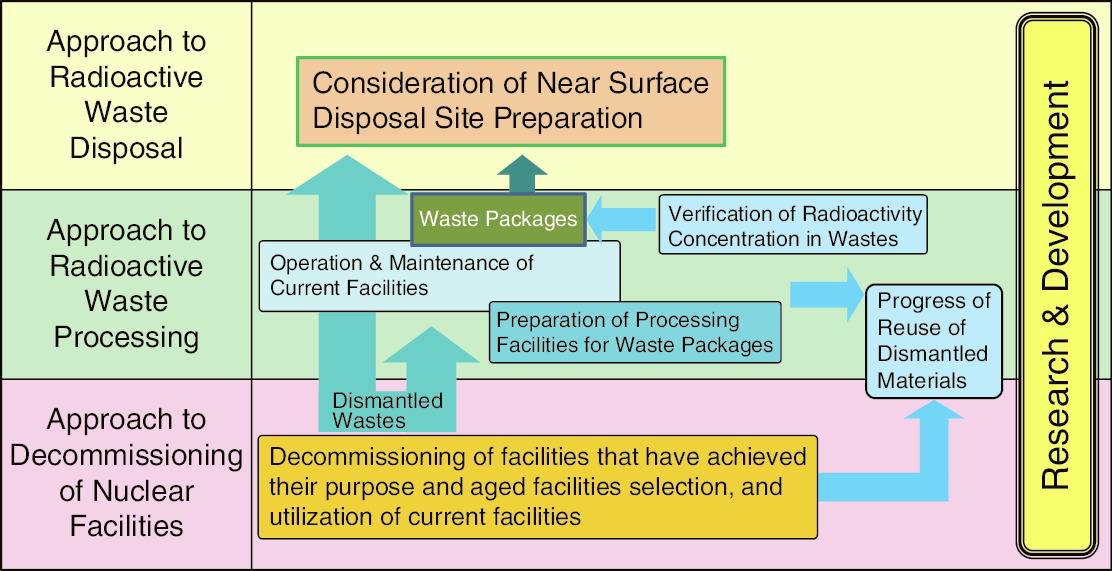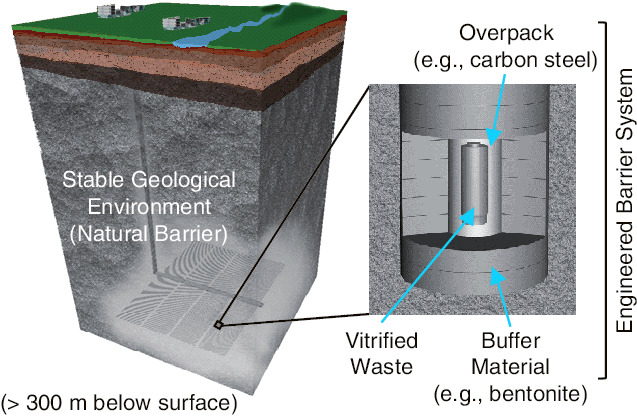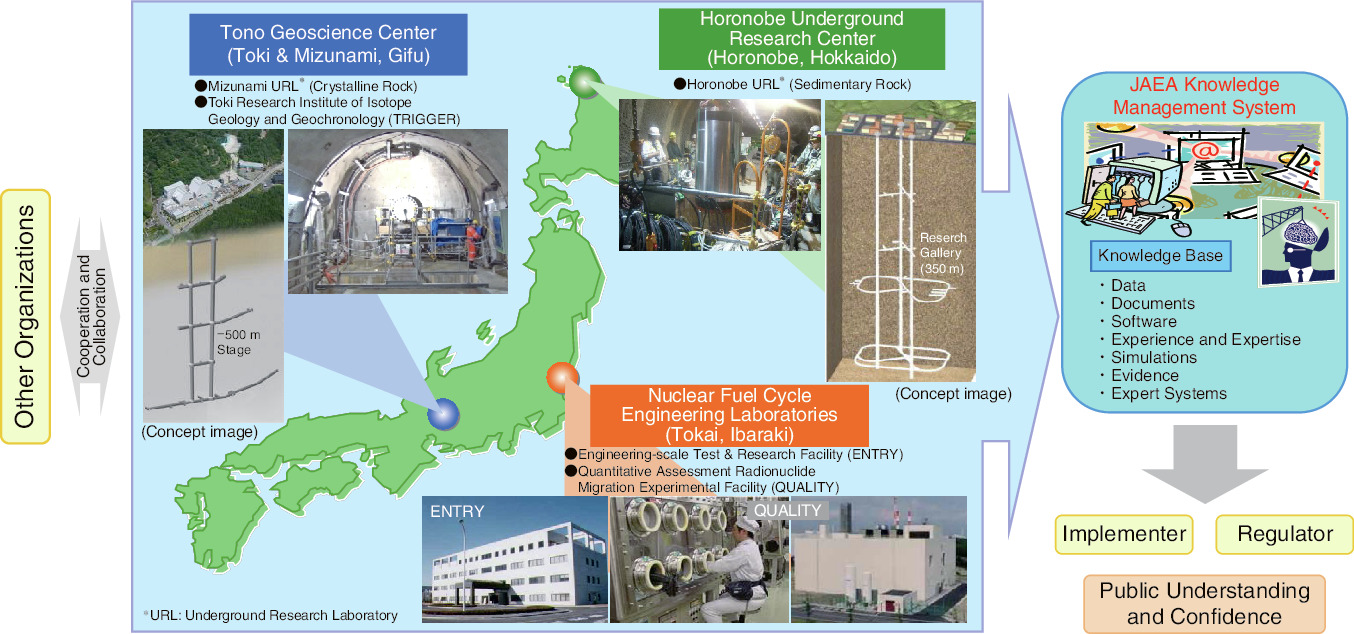
Fig.8-1 Outline of low-level radioactive waste management

Fig.8-2 Schematic view of the basic concept for geological disposal of high-level radioactive waste in Japan

Fig.8-3 Structure of JAEA R&D activities
Decommissioning of Nuclear Facilities and Radioactive Waste Management
Five old nuclear-power plants in Japan have been slated for decommissioning. Extensive decommissioning of nuclear facilities will start in the near future. For safe and appropriate nuclear-facility decommissioning and radioactive waste management, introducing new technologies and knowledge and promoting the development of technologies for advanced safety and cost reduction is necessary. We have been comprehensively developing technologies for safe and effective dismantling of nuclear facilities for minimization and stabilization of radioactive wastes and for radioactive waste disposal. Our disposal-project is intended to cover low-level radioactive wastes from research facilities at universities and private organizations, as well as from JAEA’s own facilities (Fig.8-1).
The technological development achievements in this fiscal year include
–An equivalent-model method for correcting density and source localization using multiple γ rays with different energies at the Ningyo-toge Environmental Engineering Center (Topic 8-1)
–Comparison of the activation/burn-up calculation with sampled-chemical analysis of the composition ratios of 17 candidate nuclides for safety assessment of waste disposal from post-irradiation test facilities; this research serves as a technique for verifying radioactivity concentrations in wastes (Topic 8-2)
In addition to the above, the following R&D results concerning the response to the accident at the TEPCO’s Fukushima Daiichi NPS were summarized in Chapter 1.
–Investigation of the influence of sea-water and concrete components on nuclear-fuel-reprocessing-equipment materials (Topic 1-6)
–Development of a portable small α-ray position detector (Topic 1-8)
R&D to Improve Geological Disposal Technology and Reliability in Japan
Geological disposal is an option for long-term isolation of high-level radioactive waste (HLW) produced during nuclear-power generation from human environments. This is a critical issue with which the present generation must sensibly deal, and it will remain crucial in the future regardless of any revision of the national nuclear-energy policy.
In Japan, spent fuel from power reactors is reprocessed to extract reusable uranium and plutonium for power generation. The highly active liquid waste separated from the spent fuel during chemical reprocessing is solidified into a stable glass form. Under the Japanese disposal concept, vitrified wastes are then encapsulated in a thick steel overpack surrounded by highly compacted bentonite and placed in a stable geological environment at a depth of more than 300 m below the surface (Fig.8-2).
Implementing geological disposal of HLW is a long-term project that will last over 100 years. The project begins with site selection and continues to repository construction and operation, which will be followed by backfill for repository closure. It is, thus, of great importance to proceed efficiently with the project as a national responsibility by continuously improving its sound technical basis and applying these attitudes to implementation, regulatory activities, and most importantly enhancement of public confidence. To this end, we have made and will continue to make steady progress towards R&D in various fields, including geoscience, repository engineering, and safety assessment, with the aim of improving the technologies used for reliable geological disposal in Japan.
Underground Scientific Research
At present, our R&D is focused specifically on projects at two underground research laboratories (URLs). One at Mizunami, which researches crystalline rocks, and the other at Horonobe, which researches sedimentary formation (Fig.8-3).
Various techniques and methodologies for investigating geological characteristics have been developed, and research on understanding long-term hydrological and/or mass-transport behavior has been conducted at URLs (Topics 8-3, 8-4, and 8-6). R&D on engineered barrier systems using underground galleries has started at Horonobe (Topic 8-5).
In addition, there are ongoing studies on tectonics, volcanic and faulting activities, and the like, to evaluate the long-term stability of geological environments in Japan. As a base technology for these studies, the development of dating techniques using advanced equipment for isotope geology and geochronology are ongoing at the Toki Research Institute of Isotope Geology and Geochronology (TRIGGER) (Topic 8-7).
Research and Development on Geological Disposal Technologies
In parallel with such geoscientific efforts, we are conducting an extensive study on repository design and safety assessment of the disposal system at the Nuclear Fuel Cycle Engineering Laboratories in Tokai based on experiments and models of the long-term evolution of the disposal system and radionuclide migration (Topics 8-8 and 8-9). These studies exploit data and information that were obtained at both URLs.
The prototype knowledge-management system that was developed in 2010 is being improved and managed steadily. Furthermore, the results of the R&D activities have been summarized as a web-based report (CoolRep), which is available on JAEA’s public website (CoolRep: https://kms1.jaea.go.jp/CoolRep/english.html).
Improvement of Safety and Technologies of Fuel Reprocessing
The Tokai Reprocessing Plant promotes high-level radioactive-liquid-waste vitrification and Pu-solution solidification to MOX powder to reduce the risk to this facility caused by radioactive material stored in the solution state. The Pu solution completed solidification to MOX powder in July 2016. Vitrification of the high-level radioactive-liquid waste is planned to be completed by the 2028 Japan fiscal year. We are steadily promoting this process with a primary focus on safety. We have also developed advanced vitrification technologies as well as solidification technologies for low-level radioactive-liquid waste. Development of our solidification technologies, nitric-acid-decomposition treatment, and new-cement solidification techniques are ongoing.
The remaining nuclear material to be processed in this facility is still subject to International Atomic Energy Agency (IAEA) and Nuclear Regulation Authority (NRA) inspection, despite our risk-reducing activities. Performance improvement of the non-destructive assay (NDA) technique for plutonium-nitrate solution was conducted by joint research with Los Alamos National Laboratory in the Unites States.
In this research, we can confirm accurate and rapid evaluation of the amount of plutonium in a solution sample using three types of neutron-coincidence-counting techniques (Topic 8-10).
In addition to the above, we attempt to understand the properties of residues generated by reprocessing irradiated fast-reactor fuel (Topic 8-11).